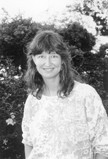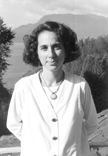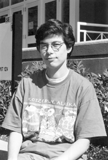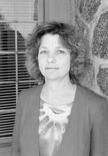Roughly 40 per cent of the university's 1,830 full-time faculty members have been appointed in the past 10 years. This pace of faculty renewal has been made possible through a program of early retirement in effect since 1986 and government funding for increased enrolment which has been in place for five years.
Fifty new faculty have been appointed this term in 10 faculties. Since 1987, there have been 751 new tenure track appointments--504 men and 245 women.
Here are some of the latest faculty appointments.
 Position: Assistant
Professor, Dept. of Earth and Ocean Sciences
Position: Assistant
Professor, Dept. of Earth and Ocean Sciences
Education: PhD, Geology (1996), Texas A&M
Courses taught: structural geology
Previous positions: Research Assistant, Dept. of Geology, University of New Brunswick (1988-90); Teaching Assistant, Centre for Tectonophysics, Texas A&M (1991-92); Research Assistant, Texas A&M (1993-95)
Recent publication: The Role of Veining and Dissolution in the Formation of Fine-Grained Mylonites: The McConnell Thrust
Teaching/Research objectives: "How are fault zones (and at greater depths, shear zones) developed and what controls the onset of earthquakes? My research concentrates on the evolution of continent-scale fault zones, with emphasis placed on the physical processes (mechanisms) responsible for their formation."
 Position: Professor,
Dept. of Physics and Astronomy, Warren Chair in Subatomic Physics
Position: Professor,
Dept. of Physics and Astronomy, Warren Chair in Subatomic Physics
Education: PhD (1972), Imperial College, University of London
Courses taught: introduction to subatomic physics, nuclear and particle physics, fundamental physics laboratory
Previous positions: Staff Physicist, CERN (1977-81); Research Scientist, Institute of Particle Physics (1983-95); Professor, Dept. of Physics, University of Toronto (1981-95)
Recent publication: Extraction of the Gluon Density of the Proton at Small x
Teaching/Research objectives:"I am convinced that the connection between the known forces--gravity, electromagnetism, and the weak and strong nuclear forces--is the most important question in particle physics and probably holds the solution to the problem of where mass comes from."
 Position: Assistant
Professor, Dept. of Medical Genetics
Position: Assistant
Professor, Dept. of Medical Genetics
Education: MD, University of Sherbrooke (1981); Speciality in Pediatrics and Molecular Genetics, UBC (1985, 1989-91)
Courses taught: clinical genetics, molecular genetics of single gene disorders
Previous positions: Director, DNA Diagnostic Laboratory, Shaughnessy Hospital (1989-present); Acting Clinical Director, Provincial Medical Genetics Programme (1994-present)
Recent publication: Linkage Analysis of Two Canadian Families Segregating for X-linked Spondylepiphyseal Dysplasia
Teaching/Research objectives: "I am currently analysing the correlation between different changes in a specific gene and the signs and symptoms of the disease (e.g. Marfan's Syndrome). I am also engaged in family studies involving DNA mapping of genes. These studies provide a starting point to identifying the exact location of the gene responsible for the disease in the family."
 Position: Assistant
Professor, Marketing
Position: Assistant
Professor, Marketing
Education: PhD, Experimental Social Psychology (1993), University of Toronto
Courses taught: introduction to social psychology, interpersonal behaviour, psychology of social behaviour
Previous positions: Assistant Professor, Dept. of Psychology, U of T (1995-96)
Recent publication: Lucky Events and Beliefs in Luck: Paradoxical Effects on Confidence and Risk-Taking
Teaching/Research objectives: "Behavioural research has developed to a point at which we can offer reasonably sophisticated ideas about what factors are important in determining perceptions, judgment and behavior. Contemporary theories appreciate that behavior is driven by a range of motives, not always rational. My research aims to understand how factors work together to produce rational and irrational behaviour. Answers to this question have the potential to significantly improve decisions that individuals make and help them adapt to an ever changing world of choice."
 Position: Assistant
Professor, Dept. of English
Position: Assistant
Professor, Dept. of English
Education: PhD, Modern Literature in English (1991), Queen's University
Courses taught: major authors survey, introduction to Canadian literature, comparative literature, fictions of cultural difference, Canadian literature and multiculturalism
Previous positions: Teaching Assistant, Queen's University (1989-90); Sessional Lecturer, University of Western Ontario (1991-92); Part-time Sessional Lecturer, UBC (1992-94, as part of Isaak Walton Killam Postdoctoral Fellowship); Graduate Instructor, UBC (1994); Sessional Lecturer, UBC (1994-1996)
Recent publication: Ugly Beauty: John Zorn and the Politics of Postmodern Music
Teaching/Research objectives: "The polyphony that variously constitutes Canadian culture -- the proliferation of stances, positions, voices and texts emerging within the Canadian context -- offers us an opportunity to engage in a fundamental self-questioning and to re-think many of our assumptions about identity and difference, about nationality and otherness, and about culture itself."
 Position: Assistant
Professor, Dept. of Computer Science
Position: Assistant
Professor, Dept. of Computer Science
Education: PhD, Computer Science (1996), University of Washington
Courses taught: computer evolution
Previous positions: Research Assistant, Dept. of Computer Science, University of Alberta (1986); Software Designer, B.C.-based MPR Teltech Ltd. (1987-93); Research Assistant, Dept. of Computer Science and Engineering, University of Washington (1992-96)
Recent publication: Assisting an Experimental Re-engineering of Excel with Reflexion Models
Teaching/Research objectives: "Software systems are sometimes referred to as the most complex artifacts ever created by humans. My teaching objectives include providing students with the knowledge and skills necessary to tackle the building of these systems. My research interests focus on the investigation and development of tools and techniques enabling software engineers to more cost effectively modify and extend the usefulness of existing systems."
 Position: Assistant
Professor, Voice and Opera
Position: Assistant
Professor, Voice and Opera
Education: Voice Performance Program, Faculty of Music, University of Toronto (1967-70); Opera School Program, Faculty of Music, University of Toronto (1970-71)
Courses taught: vocal instructor, Faculty of Music, University of Toronto (1978-95)
Previous positions: Appeared as soloist with North American symphony orchestras in Britten's War Requiem, Handel's Messiah, Mahler's Eighth Symphony, Beethoven's Ninth Symphony and Verdi's Requiem. Operatic roles in Donizetti's Lucia di Lammermoor, Britten's Noah's Flood, Mozart's Marriage of Figaro and Magic Flute and Rossini's Barber of Seville
Teaching/Research objectives: "I will guide young singers in developing a vocal technique which will facilitate the expression of their unique personalities when singing in several languages and in different styles."
 Position: Professor,
Dept. of Educational Psychology and Special Education, Dorothy C. Lam Chair in
Special Education
Position: Professor,
Dept. of Educational Psychology and Special Education, Dorothy C. Lam Chair in
Special Education
Education: PhD, Psychology (1966), Yale
Courses taught: developmental psychology, language development, research methods, learning disabilities, psychoeducational assessment
Previous positions: Assistant Professor, University of Missouri (1966-68); Professor, Dept. of Psychiatry, McMaster University Medical Centre (1968-84); Professor, Depts. of Instruction and Special Education/ Applied Psychology, Ontario Institute for Studies in Education (OISE, 1984-95); Executive Head, Graduate Studies, OISE (1987-91)
Recent publication: Learning Disabilities and Suicide: A Causal Connection
Teaching/Research objectives: "My interests lie in the area of learning disabilities, such as dyslexia and other learning problems. I have been studying the best way to predict which children will have learning disabilities so they can be provided with help from the educational system before the problems become too severe."